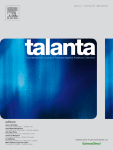Ver ítem
- xmlui.general.dspace_homeCentros Regionales y EEAsCentro Regional Entre RíosEEA ConcordiaArtículos científicosxmlui.ArtifactBrowser.ItemViewer.trail
- Inicio
- Centros Regionales y EEAs
- Centro Regional Entre Ríos
- EEA Concordia
- Artículos científicos
- Ver ítem
Matrix interference evaluation employing GC and LC coupled to triple quadrupole tandem mass spectrometry
Resumen
Gas and liquid chromatography coupled to triple quadrupole tandem mass spectrometry are currently the most powerful tools employed for the routine analysis of pesticide residues in food control laboratories. However, whatever the multiresidue extraction method, there will be a residual matrix effect making it difficult to identify/quantify some specific compounds in certain cases. Two main effects stand out: (i) co-elution with isobaric
matrix
[ver mas...]
Gas and liquid chromatography coupled to triple quadrupole tandem mass spectrometry are currently the most powerful tools employed for the routine analysis of pesticide residues in food control laboratories. However, whatever the multiresidue extraction method, there will be a residual matrix effect making it difficult to identify/quantify some specific compounds in certain cases. Two main effects stand out: (i) co-elution with isobaric
matrix interferents, which can be a major drawback for unequivocal identification, and therefore false negative detections, and (ii) signal suppression/enhancement, commonly called the “matrix effect”, which may cause serious problems including inaccurate quantitation, low analyte detectability and increased method uncertainty.
The aim of this analytical study is to provide a framework for evaluating the maximum expected errors associated with the matrix effects. The worst-case study contrived to give an estimation of the extreme errors caused by matrix effects when extraction/determination protocols are applied in routine multiresidue analysis. Twenty-five different blank matrices extracted with the four most common extraction methods used in routine analysis (citrate QuEChERS with/without PSA clean-up, ethyl acetate and the Dutch mini-Luke “NL” methods) were evaluated by both GC-QqQ-MS/MS and LC-QqQ-MS/MS. The results showed that the presence of matrix compounds with isobaric transitions to target pesticides was higher in GC than under LC in the experimental conditions tested.
In a second study, the number of “potential” false negatives was evaluated. For that, ten matrices with higher percentages of natural interfering components were checked. Additionally, the results showed that for more than 90% of the cases, pesticide quantification was not affected by matrix-matched standard calibration when an interferent was kept constant along the calibration curve. The error in quantification depended on the concentration level. In a third study, the “matrix effect” was evaluated for each commodity/extraction method. Results showed 44% of cases with suppression/enhancement for LC and 93% of cases with enhancement for GC.
[Cerrar]

Autor
Uclés, Samanta;
Lozano Fernández, A.B.;
Sosa, Alexis Lionel;
Parrilla Vázquez, Piedad;
Valverde García, Antonio;
Rodríguez Fernández-Alba, Amadeo;
Fuente
Talanta 174 : 72–81. (2017)
Fecha
2017
ISSN
0039-9140
Formato
pdf
Tipo de documento
artículo
Palabras Claves
Derechos de acceso
Restringido
 Excepto donde se diga explicitamente, este item se publica bajo la siguiente descripción: Creative Commons Attribution-NonCommercial-ShareAlike 2.5 Unported (CC BY-NC-SA 2.5)
Excepto donde se diga explicitamente, este item se publica bajo la siguiente descripción: Creative Commons Attribution-NonCommercial-ShareAlike 2.5 Unported (CC BY-NC-SA 2.5)

